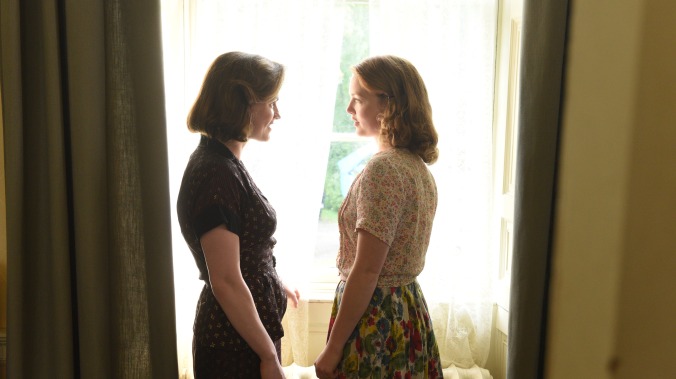Tell It To The Bees crushes a tender midcentury love story under the weight of melancholy


There’s a certain kind of drama favored by the novelist Ian McEwan: wistful British period pieces, like his Atonement or On Chesil Beach, that play out romantic tragedy in slow motion, capturing the struggle of the U.K.’s mid-century recovery period. Fellow British author Fiona Shaw put a queer spin on that formula with her novel Tell It To The Bees, which has now been adapted with refined austerity by director Annabel Jankel (co-creator of Max Headroom and co-director of the cult favorite Super Mario Bros.) and screenwriting sisters Henrietta and Jessica Ashworth. This all-female team adapts Shaw’s text by painting two portraits: one of a forbidden love blooming in a small town distrustful of outsiders after World War II, the other of a lonely young boy becoming fascinated with the transformational potential of nature. In parallel, the stories track characters sloughing off their outward selves to reveal something more intimate beneath. But what Tell It To The Bees accomplishes for queer romance it abandons with an ending that is committed to unnecessary melancholy.
The film is narrated by the grown Charlie (Billy Boyd), who thinks back to 1952, the summer when he was a 10-year-old boy (Gregor Selkirk), living with his mother, Lydia (Holliday Grainger), in Scotland. Charlie’s father, Rob (Emun Elliott), is rarely around, and so mother and son have a particularly tight bond—one that other children tease Charlie about. A particularly vicious bullying incident leads his cousin, Annie (Lauren Lyle), to take him to the town’s new doctor, Jean Markham (Anna Paquin), who has returned after years away to take up the position previously held by her deceased father.
Gossip about Jean begins nearly immediately, but Charlie is fascinated by her. She gives him books to read, treats him with patience and kindness, and involves him in tending various boxes of bees on her property, encouraging Charlie to whisper to them his secrets and stories about his own life. Meanwhile, Jean and Lydia become friendly, too, but Charlie doesn’t quite understand what’s really developing between them. His confusion, and the fact that the women have to hide their relationship, set off a series of events that alter all their lives.
Charlie is our entry point for Tell It To The Bees, and Selkirk’s successful portrayal of the boy as simultaneously devoted to his omnipresent mother and yearning for the approval of his absent father excuses some of the character’s more nonsensical actions. In the hands of a lesser young actor, Charlie’s bond with the bees could come off more goofy than emotional, but Selkirk is fully involved in the scenes with the pollinators, whispering to the colony, rapping upon the boxes with his fingers, and smiling at the hum the bees produce. And he has good chemistry with both Paquin and Grainger, who each build their characters into women who recognize in each other a mutual lack of professional and romantic fulfillment.
A flashback shows Grainger’s Lydia as a smartly dressed, fleet-footed young woman whose impetuous decision to marry the handsome Rob severs her bond with her family. Years of isolation and drudgery at the local mill have dimmed her, but once Lydia’s relationship with Jean begins, Grainger’s demeanor changes; her energy morphs from concerned to joyful. She’s well-matched by Paquin, whose more experienced Jean can’t deny her attraction to Lydia. A scene where Jean wades into frigid depths to retrieve a toy sailboat Charlie lost and then returns on shore to the cheering and grateful Lydia and her son is the turning point for her role within the family, and Paquin plays it with spontaneous confidence. The performance recalls her later seasons as Sookie Stackhouse on True Blood, playing a woman comfortable in her own body and with her own desires but well aware of the violence others will exhibit in response.
“He said this town was too small for secrets,” Jean says of her father, and Jankel’s unfussy directing style—the way she watches townspeople watching each others—makes clear the barely buried resentment felt for women who dare to deviate even slightly from their expected roles of mother, daughter, and wife. Perhaps inevitably, there’s a late turn toward brutality, which is when Tell It To The Bees starts to feel constricted by the conventions of its various genres. Much of what’s unique about these lovers is flattened by traumatic elements forced upon them, settling Tell It To The Bees into a melancholy that is less required for this story than it is mandatory for an outdated kind of LGBTQIA+ story, the kind where sadness is the only conclusion allowed for the characters.
Shady medical procedures and rape. Domestic violence and child abuse. Bullying and death. The film goes all-in with the terrible things that could happen to Charlie, Lydia, and Jean, deviating from the more whimsical angle of Charlie’s relationship with the bees and the gentleness of its main romance; in the final scenes, all hopeful possibility begins to unravel. Paquin and Grainger are likable together, and the film’s exploration of womanhood as an identity often dictated by men is handled effectively. But the conclusion of Tell It To The Bees doesn’t quite land with the emotional resonance it requires, falling back on clichés the movie had previously quite effectively upended.